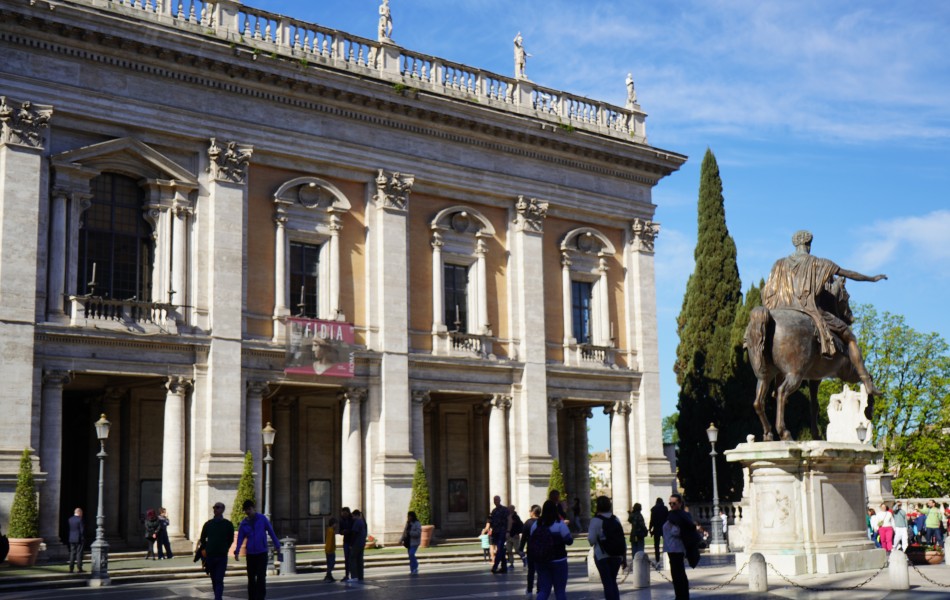The 10 Best Things to See on the Capitoline Hill: History, Art, and unforgettable views of Rome
Hidden gems and artistic masterpieces of the Capitoline Hill, from the Renaissance to Ancient Rome

30 August 2024
Things to do in RomeCapitoline Hill, one of the seven hills on which Rome was founded, is a place rich in history, art, and culture. This hill was not only the center of political and religious power in ancient Rome, but it also remains a symbol of the city throughout the centuries.
The Capitoline Hill is geographically and historically located between the ancient heart of the city, represented by the Roman Forum, and the River Tiber, which has always played a crucial role in the life of Rome. This position makes it one of the most symbolic and strategic locations in the city, directly connecting the political center with the main waterway.
Here is a travel guide to the 10 best things to see on Capitoline Hill, combining antiquity, the Renaissance, and breathtaking views.
1. Piazza del Campidoglio
Designed by Michelangelo Buonarroti in the 16th century, Piazza del Campidoglio is one of the most elegant and iconic squares in Rome. Its symmetrical design, star-shaped pavement, and surrounding buildings make it a masterpiece of the Renaissance. At the center of the square stands the replica of the famous equestrian statue of Marcus Aurelius, one of the few ancient bronzes that survived being melted down during the Middle Ages.
2. The Statue of Marcus Aurelius
The original Statue of Marcus Aurelius is housed inside the Capitoline Museums, to protect it from the elements. This gilded bronze statue, dating back to the 2nd century AD, depicts the emperor on horseback and is one of the most important examples of Roman imperial portraiture. It was mistakenly believed to represent Constantine, which saved it from destruction.
3. The Capitoline Museums
The Capitoline Museums are the first public museum in history, founded in 1471 by Pope Sixtus IV. They house a vast collection of ancient and Renaissance art, including the Capitoline Wolf, a symbol of Rome, and the Dying Gaul, a masterpiece of Hellenistic art. The museums are divided between the Palazzo dei Conservatori and the Palazzo Nuovo, both overlooking Piazza del Campidoglio.
4. The Colossal Statue of Constantine
Within the courtyard of the Palazzo dei Conservatori, you can admire the colossal Statue of Constantine the Great. This sculpture, originally located in the Basilica of Maxentius in the Roman Forum, consists of enormous fragments, including the head, a hand, and a foot, which give an idea of its original grandeur. Constantine is known as the emperor who legalized Christianity in the Roman Empire.
5. Palazzo Senatorio
The Palazzo Senatorio, which stands on the site of the ancient Roman Tabularium, is now the seat of Rome’s city council. This building was also redesigned by Michelangelo, who planned the majestic central staircase and facade. The Campidoglio Tower, rising above the palace, offers a breathtaking panoramic view of Rome, particularly the Roman Forum.
6. Panoramic View of the Roman Forum
From the terrace of the Tabularium, included in the Capitoline Museums and located beneath the Palazzo Senatorio, you can enjoy one of the best views of the Roman Forum. This ancient heart of Roman public life is visible in all its extent, allowing you to admire monuments like the Arch of Septimius Severus and the Temple of Saturn. This unique perspective lets you appreciate the immensity and grandeur of the ancient ruins.
7. Basilica of Santa Maria in Aracoeli
The Basilica of Santa Maria in Aracoeli, located on the right side of Capitoline Hill, is one of the oldest churches in Rome. Built on the remains of a Roman temple, this medieval church is famous for its steep staircase of 124 steps and richly decorated interior. Don’t miss the Bambinello of Aracoeli, a 15th-century wooden statue of the Infant Jesus, revered by Romans for its alleged miraculous powers.
8. Altar of the Fatherland
At the base of Capitoline Hill lies the imposing Altar of the Fatherland or Vittoriano, a monument dedicated to Victor Emmanuel II, the first king of Italy. Constructed from white marble, with imposing columns and statues, this monument is visible from much of the city. From the panoramic terrace, accessible by an elevator, you can enjoy a spectacular view of Rome, including the Roman Forum and the Colosseum.
9. Statue of Cola di Rienzo
The Statue of Cola di Rienzo is located at the foot of the staircase leading to Capitoline Hill. Cola di Rienzo was a tribune who, in the 14th century, attempted to restore the Roman Republic. His figure is emblematic of the passion for Rome and the desire to return the city to its former glory.
10. Lapidary Gallery
The Lapidary Gallery, located in the underground of the Palazzo dei Conservatori, is part of the Capitoline Museums. This collection of Roman inscriptions and epigraphic fragments offers a glimpse into the daily life and religious beliefs of ancient Rome. The inscriptions range from religious dedications to epitaphs, providing a fascinating insight into Roman society.
Capitoline Hill is a place where the past and present meet, offering visitors a unique experience in the heart of Rome. From Renaissance masterpieces to the ruins of ancient Rome, including breathtaking panoramic views, this hill is a must-see for anyone wishing to discover the history and timeless beauty of the city.
Our categories:
You may also be interested ...

Vatican Private Tour with Sistine Chapel & St. Peter's Basilica: Renaissance’s Wonders
Private tour
Discover with a skip the line Private Vatican Tour the Sistine Chapel, Vatican Museums and St Peter’s Basilica
starting from: € 375

Colosseum Guided Audio Tour with Roman Forum and Palatine Hill
Private tour
Discover Ancient Rome’s secrets and history with our immersive Colosseum guided audio tour, rich in image and content
starting from: € 51 € 42